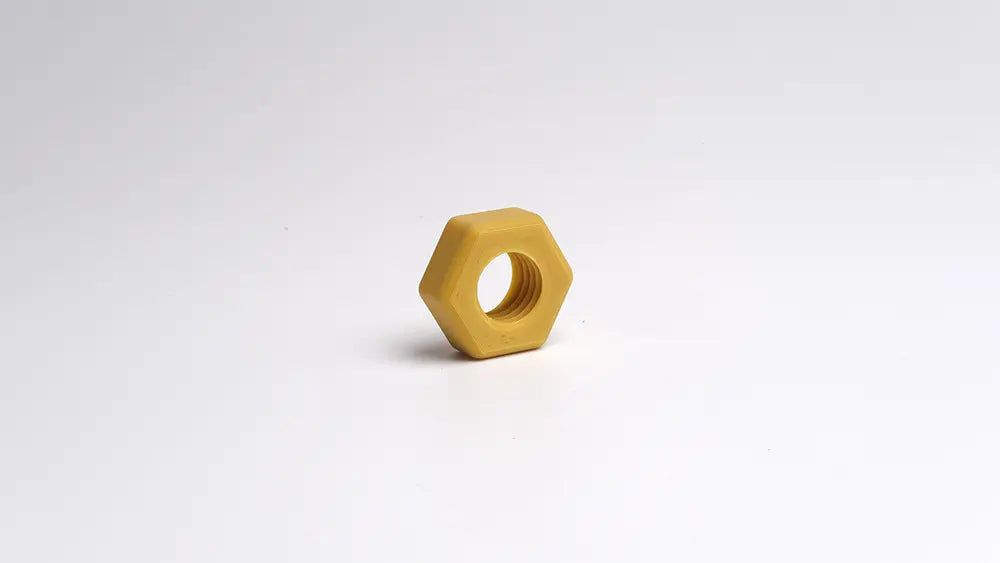
ABS (Acrylonitrile Butadiene Styrene)
Share
ABS is a durable thermoplastic polymer known for its toughness, heat resistance, and impact strength. It is widely used in the manufacturing industry, particularly in injection moulding, due to its strong mechanical properties. ABS is a great choice for functional parts, though it can be more challenging to print compared to PLA or PETG due to higher warping tendencies and the need for controlled printing environments.
Common Uses:
- Automotive parts
- Enclosures for electronics
- Prototyping
- Toys (e.g., LEGO bricks)
- Industrial applications
ABS Variations:
There are several variations of ABS available to choose from. We’ll explore some of these options and their properties below:
ABS+
ABS+ is an improved version of standard ABS, formulated to reduce warping and improve adhesion between layers.
It is commonly used for larger prints or those requiring higher dimensional stability.
ABS HS (High Strength)
ABS HS offers enhanced strength and rigidity, making it ideal for parts that will undergo stress or impact.
This added strength makes it an ideal choice for structural parts, tooling, or components requiring more durability.
ABS Fireproof
A specialised version of ABS with fire-resistant additives, providing greater safety in applications requiring flame retardance.
This material is ideal for parts in electronics or automotive industries where fire safety is a concern.
ABS CF (Carbon Fibre)*
This variation of ABS is reinforced with carbon fibre to enhance strength and stiffness while reducing weight.
These properties make it suitable for lightweight structural parts that need to withstand mechanical stresses.
*For more information on printing with ABS CF, refer to the Carbon Fibre guide.
ABS Variations Comparison Table
|
Material |
Strength |
Heat Resistance |
Surface Finish |
Common Applications |
|
ABS |
High |
High (~100°C) |
Glossy |
Prototyping, automotive parts, enclosures |
|
ABS+ |
High |
High (~100°C) |
Glossy |
Large prints, functional prototypes |
|
ABS HS |
Very High |
High (~100°C) |
Glossy |
Structural parts, high-impact components |
|
ABS Fireproof |
High |
High (~100°C) |
Glossy |
Electronics, automotive, fire-resistant parts |
|
ABS CF |
Very High |
High (~100°C) |
Matte |
Lightweight structural parts, tooling |
Pros and Cons of ABS:
Using ABS has many advantages, however, it also has some disadvantages. Understanding the pros and cons can help you determine whether ABS is the right filament for you and your project.
Pros:
- Durable and strong: ABS is one of the most robust filaments, with excellent impact and wear resistance.
- High heat resistance: ABS can withstand temperatures up to 100°C or more, making it suitable for applications in warmer environments.
- Post-processing friendly: ABS can be easily sanded, machined, and smoothed using acetone vapour, giving prints a polished, professional finish.
- Affordable: ABS is widely available and generally less expensive than advanced filaments, such as Nylon or Polycarbonate.
Cons:
- Warping issues: ABS is prone to warping and shrinking during cooling, making it challenging to print without a heated bed or enclosed build space.
- Fumes: ABS emits strong odours and potentially harmful fumes while printing. To combat this, you’ll require good ventilation and/or a fume extraction system.
- Requires higher temperatures: ABS needs a higher print and bed temperature compared to PLA or PETG, which may limit compatibility with some 3D printers.
- Less UV-resistant: ABS is prone to degrading over time if exposed to sunlight, making it less ideal for outdoor applications without added protection.
Storage Tips:
ABS is somewhat hygroscopic, though not as much as PETG or PLA. Proper storage can still help maintain print quality:
- Store in an airtight container with silica gel packs to prevent moisture absorption.
- Dry before use if the filament has been exposed to moisture (use a filament dryer or low-temperature oven at 60°C for a few hours).
- Use a dry box for long-term storage to avoid any potential issues.
Environmental Considerations:
ABS is a petroleum-based plastic and is not biodegradable. Some key points to consider:
- Not biodegradable: ABS does not break down naturally and should not be disposed of in regular waste. It is better suited for recycling when possible.
- More harmful fumes: ABS emits potentially harmful fumes, so proper ventilation and safety precautions should be taken when printing.
- Durability: While not eco-friendly, ABS’s durability means it can last longer in use, reducing the need for frequent replacements in certain applications.
Generic Print Settings for ABS:
Extruder Temperature: 230°C – 260°C
Bed Temperature: 90°C – 110°C
Print Speed: 30 – 60 mm/s
Bed Adhesion: Use a heated bed with a surface like Kapton tape, ABS slurry, or a PEI sheet to improve adhesion and reduce warping
Cooling: Minimal or no cooling fan is recommended, as cooling can lead to warping and poor layer adhesion
Enclosure: It’s recommended to use an enclosed printer to maintain ambient temperature and minimise warping during cooling
Please note, print settings can vary by manufacturer. Always refer to the specific recommendations provided on the spool’s packaging or the supplier’s website before starting your print.
Need ABS for your project? Shop RAW3D’s full range here.
